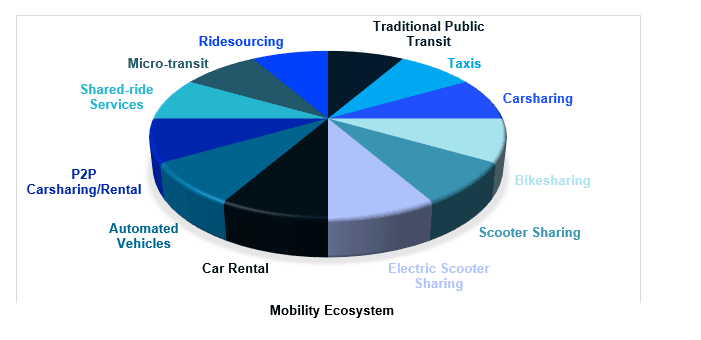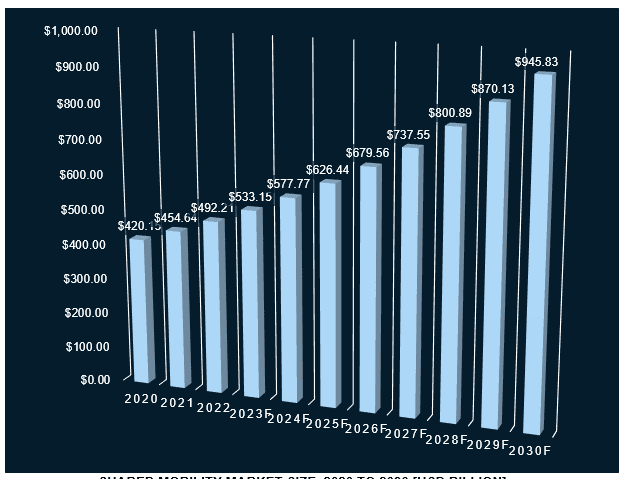“Shared Mobility: Transforming Transportation through Collaboration and Convenience”
The global shared mobility market was estimated at USD 454.64 billion in 2021 and is expected to reach over USD 945.83 billion by 2030, expanding growth at a CAGR of 8.5 % from 2022 to 2030. Shared transport or shared mobility is transportation in which travelers share vehicles as a group at the same time or as individual rentals over a period of time, thereby sharing transportation system. This creates a hybrid between private car use and public transport. This is a transport strategy that allows users to access transport services as needed. Shared mobility is an umbrella term that encompasses different modes of transportation such as car-sharing, bike-sharing, ridesharing, carpooling, and micro-transit.

Mobility Ecosystem
Benefits of Shared Mobility
Shared mobility offers many social, environmental, and transport-related benefits. It also improves economic returns and drives cost savings in many scenarios. With various innovative approaches in social networking, location-based services, and internet technology, intelligent mobility services are rapidly gaining popularity in today’s market.
More Economical:
Shared mobility is more economical as it is cheaper than buying and maintaining a vehicle. Car-sharing services have great potential to create positive social effects in terms of congestion and pollution and to save energy consumption. Shared mobility reduces the use of individual passenger vehicles and helps get people to their destinations more efficiently.
Eco-friendly:
Shared mobility means fewer vehicles, further reducing CO2 emissions and polluting the environment. According to the US Environmental Protection Agency, a typical car emits 4.6 tons of carbon dioxide each year. Millions of vehicles in cities emit half a million tons of carbon dioxide into the atmosphere each year.
Urban Mobility:
With increasing urbanization and population growth, road traffic is becoming a major problem in cities around the world. Smart mobility benefits both commuting citizens and local governments, providing full interoperability between public transport and the private sector.
Flexibility:
There are many different modes of transport so that travelers can choose the mode of transport that best suits their particular situation.
Safety:
Mobility sharing significantly reduces fatalities and injuries.

SHARED MOBILITY MARKET SIZE, 2020 TO 2030 [USD BILLION]
How Shared Mobility Will Change the Automotive Industry?
The development of shared mobility and on-demand services, as well as growing environmental concerns, are already reducing global vehicle production. According to Statista, its down from 97 million in 2018 to 78 million in 2020. Automakers are responding to this challenge by introducing mobility on demand into their business. Daimler AG was one of the first manufacturers to launch his startup car2go (now Share Now) in 2008, offering rentals of his Smart and Mercedes-Benz vehicles via a free app. The trend continues: In 2020, Hyundai Motor Group launched the Mocean Carshare program for Los Angeles to provide access to low-emission hybrid electric vehicles from Kia and Hyundai. As such, automakers seem very aware of the upcoming changes and ready to integrate them into common transport.
Key Trends
Also known as mobility on demand or mobility as a service, MaaS services offer a high-tech way to plan trips using a variety of transportation modes. On their smartphones, users receive a selection of ready-made solutions on how to get from point A to point B, along with routes based on all available transportation modes and congestion. In addition, users can choose the best route in terms of cost, travel time and comfort level, book all transportation services included in their trip and pay with one account. In a perfect world, MaaS apps would work in different cities and countries, eliminating the need for users to switch between accounts and subscriptions.
Conclusion
Public transit agencies, government agencies, and automakers are all keen to invest in shared mobility and MaaS, but there’s one more thing to consider: It’s user behavior. In addition to analyzing mobility patterns for shared, autonomous and connected urban transport, we need to foster a shift in mindset towards vehicle-as-a-service. Since travel is not as logical as many think, the new mobility ecosystem should be able to offer personalized services and flawless user experience while promoting the principles of environmental value and quality of life.
Author: Bobby Singh
